Grooming
Lifestyle Diseases Poll 2016

FWD conducted a survey featuring 100 men and women aged 16-60 to learn how well they knew about four major lifestyle-related ailments
Words by Likhitha P. Nair & Atheena Wilson Photographs from Various Sources
Know thy enemy’ – this has stood true on a battlefield, and often in life. It applies to unexpected and calculated difficulties in certain circumstances; most prevalent in health conditions. For centuries man has had to fare a waging war against diseases. With the accidental advent of medicines, many lives were saved and health enhanced. However, when we finally found cures to several life-threatening ailments, our lifestyle and habits changed towards roads of ruin. From the food to work ,everything started to have adverse affects on our health, eating into our lives in the form of lifestyle diseases.
Sugar doesn’t get you high diabetes
Diabetes is characterised by irregularities in blood sugar level, which is brought about by the body’s incapability to process it. It is generally classified into four – Type 1, Type 2, pre-diabetes and gestational diabetes. In sync with what 78.1% of our target crowd believes, diabetes is most common in adults between 45 and 60 years of age. According to the Centres for Disease Control and Prevention, there were 1.7 million new diabetes cases, and a majority of the patients belonged to this age group. While environmental factors may expedite onset of Type 1 diabetes, genetic susceptibility plays a major role in triggering Type 2. A 20.5% of the audience believe that stress could be a factor that caused the recent increase in diabetes patients. Mental stress causes a rise in blood sugar for Type 1 diabetes patients, while physical stress – like injury or a wound could have this effect on either kind of diabetes patients, which proves this assessment true. A 60.3% on the other hand believed that modern lifestyle is the reason for an increase in diabetes.
Awareness Levels
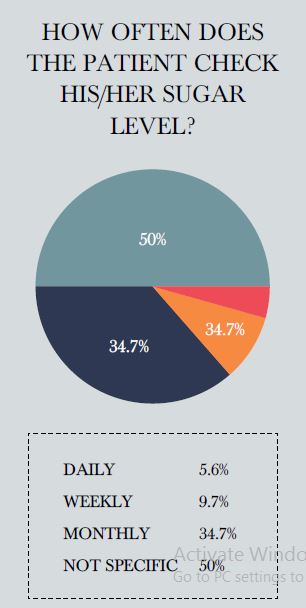
Nearly 44 lakh Indians in their most productive years — aged 20 to 79 years — aren’t aware that they are diabetic, a disease that exposes them to heart attack, stroke, amputations, nerve damage, blindness and kidney disease. While only 20% said that they would check diabetes at home using devices, almost 55% opted clinics or hospitals to be the place of diagnosis. Collectively a 22% of our audience believed that diet and exercise is a cure for diabetes, which was negated by experts. Exercise and diet almost always only supplements insulin or non-insulin medication provided for Type 1 and two diabetes, as believed by 74% of our target crowd. Constant monitoring and regulation of blood sugar is important.While only 9% believed that blood sugar needs to be checked daily in diabetes patients, the majority (50%) believed that it only needs to be checked once a month. It’s recommended that a diabetes patient on medication must check his/her blood sugar thrice daily!
Most welcomed treatment by people
74% Medicine intake (tablets/insulin)
15% Exercise
11% Diets
Heart of the Problem – Heart Diseases
The heart is arguably the most functional organ in our bodies. Since it does most of the work, a heart is the first organ to be affected by clumsy lifestyle and food habits, and this could prove to be fatal. Except for few congenital heart diseases, most of the other ailments are related to food intake, lack of exercise, substance abuse and stress. These could include stroke, cardiac arrest, peripheral artery disease and high blood pressure.

Which heart condition often leads to heart diseases?
33% Coronary artery disease
62% Heart block
01% Enlarged heart
04% Other
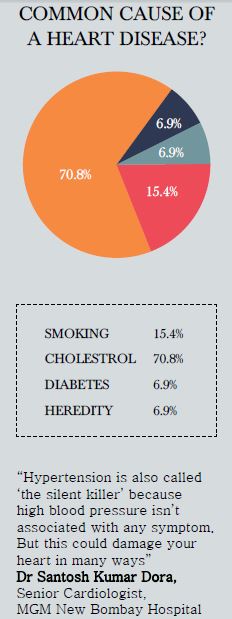
Which is the most common heart disease?
18.1% Coronary artery diease
55.6% High blood pressure
19.4% Cardiac arrest
6.9% Stroke
The Cause of It
Of our samples, 55.6% believed high blood pressure to the most common type of heart disease, but this may not be true. According to the Californiabased CADI (Coronary Artery Disease among Asian Indians) Research Foundation, India has around 62 million heart patients in 2015, and most of them suffer from congestive heart failure, a condition characterised by the heart’s inability to pump blood to the body. This could happen due to the collection of fluids in the body and the onset is general between 40 to 60 years of age – as rightly pointed out by 82% of our audience. Heart diseases could cripple the body in multiple ways. But the most common symptom pointed out during the poll was chest pain and pressure by a majority of 75%. This condition – referred to as angina, causes a discomfort, heaviness, pressure, aching, burning, fullness, squeezing, or painful feeling in the chest.
Other Factors
There could be multiple causes for heart disease. The most common one, though, is a condition called ‘atherosclerosis’ – caused by the deposit of cholesterol plaque on the walls of the artery. This could lead to insufficient blood flow and hence a heart failure. Of the lot, approximately 15% believed smoking to be the most common reason. Smoking also increases the risk of developing cardiovascular diseases, which includes coronary heart disease and stroke.
Dangerous Curves Ahead – Obesity

Perhaps, the most obvious one. But there’s been a major question of perception and whether the technical indicator is known. It’s hard to judge the difference between overweight and obese but 80% were aware that the body mass index for being obese is 30 and above. Looking into the causes we got some insights from Dr Sonia Suresh (MBBS, DNB). “The main problem with urban lifestyle, in general, is the fact that we consume too much food. Four full meals a day was fine when there was enough physical work in the daily routine. But today life is heavily mechanised, which means you don’t really need to take in as much food.”

What are the accepted treatments for obesity?
4.5% Medication
94% Exercise and diet
0% Surgery
1.5% Other
With relation to Body Mass Index (BMI), which of the following considers a person to be obese?
17% BMI < 30
80% BMI > 30
03% Other
Knowing The Cause
The survey did not negate this. When asked about what causes obesity, the majority (47%) looked at the overall cause – inactive lifestyles compared to the narrowed view, improper food habits ( 44.3%), but a minority (5.7%) said that hereditary was also an important factor.
You Are What You Eat
There is much speculation on what has catapulted such drastic obesity over time. Dr Sonia explains, “ The traditional Indian diet is rich in starch. That is why limiting the quantity of intake is crucial.” In the study, 69.1% believed that fat is the major cause of obesity, while approximately 14% believed that complex carbohydrates are a cause and 13.2% believed that refined sugars are the major culprits. According to clinical trial, low–fat diets are high in carbohydrates that accelerate weight gain. And as per fat calories, they make you feel full sooner and you don’t have to eat more. But with carbohydrates, you eat more, which leads to fat storage. However, despite the cause being so confusing, the solution is quite simple – 94% agree that exercise and diet are the only ways to tackle obesity while a slim 4.5% agreed that medication is the best possible option.

The Wrong Move – Arthritis
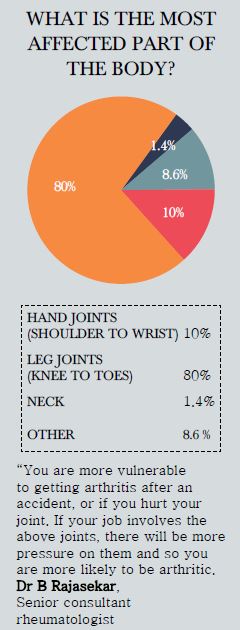
Arthritis is one of the most misunderstood diseases. Dr Alex Jacob, consultant orthopaedic surgeon, says: “Arthritis is associated with old age. There are various types of arthritis and can be divided into two main types – osteoarthritis, which is age-based and happens due to degeneration (occurs due to a birth defect or misalignment) and rheumatoid arthritis that can affect at any age.” In the survey, our samples show that women are the most affected (54.3%) which slightly mismatched with the concept that workers engaged in heavy duty are most prone to being affected (52. 9%). Though, 52.5% of the sample were convinced that rheumatoid arthritis was the most common type, only 14.5% believed that arthritis was hereditary. It was also evident that many believed arthritis is age-bound as no one believed arthritis could affect children. When asked what’s the most commonly affected joint, an overpowering majority (80%), mentioned that the knees. In tandem to such an assumption, a few factors tied in, such as climbing stairs and kneeling being the most difficult activity for those suffering arthritis.
Most common arthritis type
52% Rheumatoid arthritis
44% Osteoarthritis
04% Other
Being Active
When looked into the prevention and root cause, the survey sample had a very clear idea. As Dr Alex explains, “ Obesity and unhealthy habits can possibly lead to arthritis as well. Hence, I cannot stress enough the importance of being active.” A great percentage of the survey (35.3%) agreed that the most targeted people are office-goers. The survey showed 54.3% people saying workplace affected those suffering from arthritis and there was a fair share of reasoning that lifestyle activities contributed to it: Inactivity (48%) and inappropriate food habits (37%).When it comes to the factor of remedy, Dr Alex commented. “Keep your joint supple and moving. There is a misconception that arthritis is something that will have you house bound. But with the right medication, you can be active. Similarly, 47.7% of the sample agreed exercise is the best, while 34.3% would opt for allopathic medication and a slim 1.5% would resort to surgery.
Wellness
Kintsugi: The Art of Embracing Imperfections
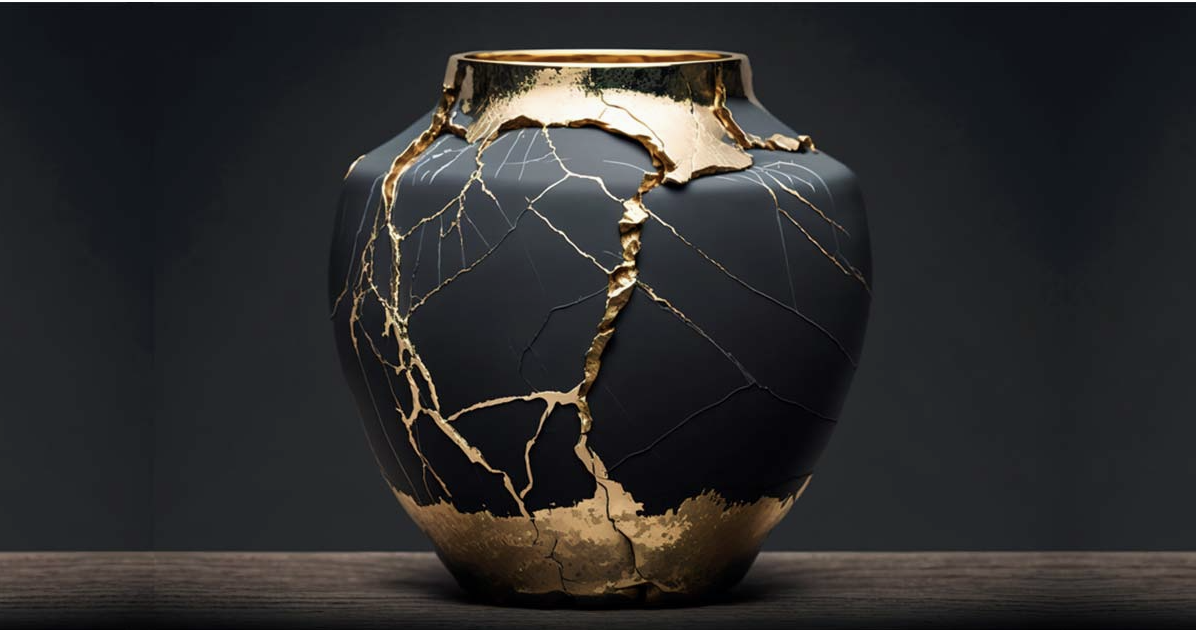
Kintsugi, an ancient Japanese art form, beautifully illustrates the philosophy of finding beauty in imperfection. Translating to “golden joinery,” Kintsugi involves the repair of broken pottery by mending the cracks with lacquer mixed with powdered gold, silver, or platinum. Instead of hiding the damage, Kintsugi emphasizes the fractures, turning them into unique, golden veins that celebrate the history and flaws of the object.
The Origins and Philosophy of Kintsugi
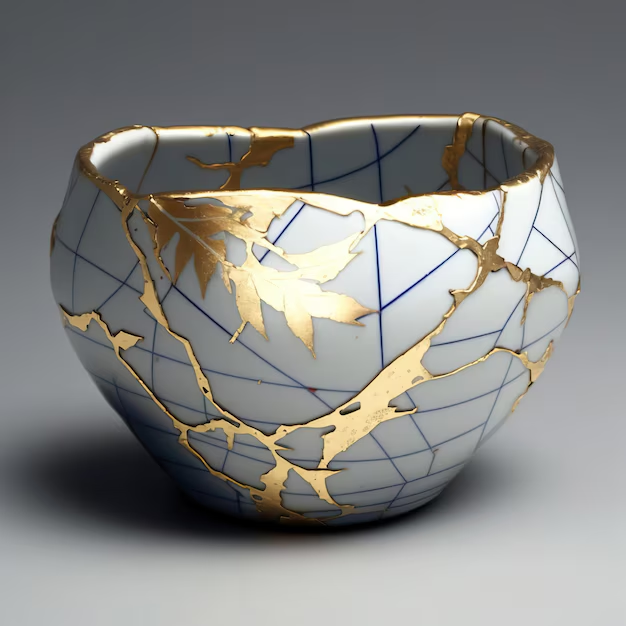
Dating back to the 15th century, Kintsugi emerged during the Muromachi period in Japan when Shogun Ashikaga Yoshimasa sent a damaged tea bowl to China for repairs. Disappointed by the lackluster results, Japanese craftsmen began experimenting with more aesthetic solutions, ultimately developing Kintsugi as a delicate blend of craftsmanship and philosophy.
Kintsugi is deeply rooted in the Japanese principle of wabi-sabi, which appreciates the transient and imperfect nature of life. The art form embodies the idea that brokenness is not something to be hidden but embraced, turning flaws into features that add character and beauty. This approach teaches us to value resilience and transformation, finding strength in vulnerability and growth in the aftermath of adversity.
The Process of Kintsugi
The Kintsugi process is meticulous and requires patience. First, the broken pottery pieces are carefully cleaned and realigned. A lacquer made from urushi, a tree sap native to Japan, is applied to bond the pieces together. Once dried, the lacquer is mixed with powdered gold, silver, or other metals, creating a brilliant contrast that highlights the cracks. The final result is a restored object, now more valuable and striking for having been broken.
There are three main techniques in Kintsugi:
- Crack Repair: Filling simple cracks with gold or another precious metal to showcase the repaired lines.
- Piece Replacement: Using gold to fill in missing parts of the pottery, creating a striking effect where the gaps were once evident.
- Joint Call: Combining different pieces from separate items to form a new, unified whole.
Symbolism and Modern Interpretations
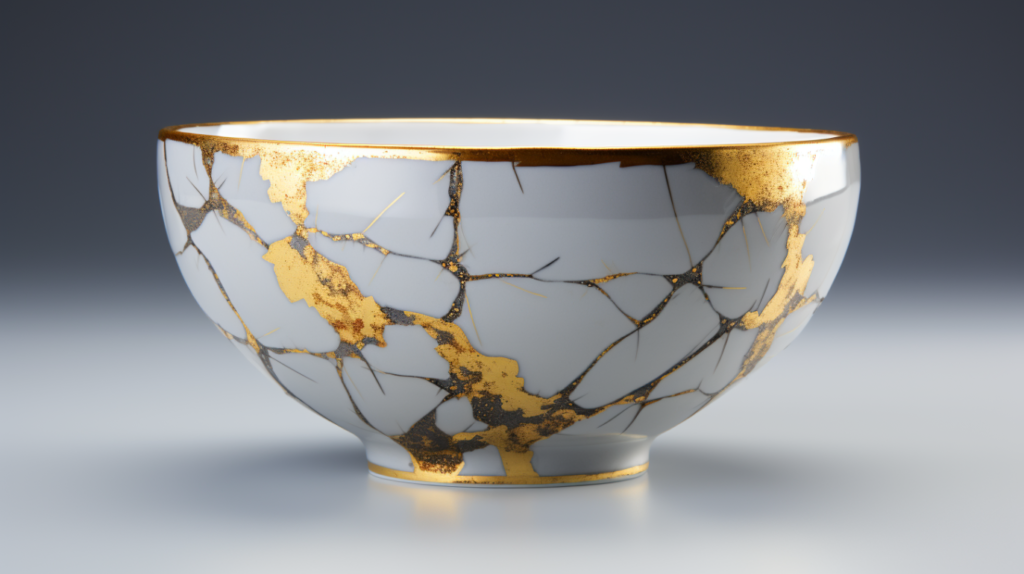
Beyond its aesthetic appeal, Kintsugi carries profound symbolism. It serves as a reminder that, like pottery, human beings can also be broken and healed, and that these imperfections become integral to our identity. In a world that often seeks perfection, Kintsugi advocates for self-acceptance and the celebration of our own personal journeys of healing and renewal.
In modern times, Kintsugi has transcended its original context and found a place in various art forms, design, and even personal development philosophies. It is often referenced in literature, fashion, and mental health discussions as a metaphor for resilience and the beauty of imperfection.
Kintsugi in Contemporary Culture
Kintsugi’s influence has reached far beyond Japan. Artists, designers, and even therapists have embraced its concepts to inspire creative projects and self-reflection. In the world of fashion, for instance, the Kintsugi technique has inspired prints, patterns, and embellishments, representing fractured beauty through clothing. In interior design, Kintsugi-inspired pottery and decor have become symbols of elegance and mindful living.
Beyond art, Kintsugi’s message resonates with personal growth and wellness. It teaches us to honor our personal scars and experiences, making them part of who we are instead of something to hide.
The Beauty of Brokenness
Kintsugi is a timeless art form that transforms brokenness into beauty, offering a powerful metaphor for life. By emphasizing the beauty in imperfections, it teaches us to embrace flaws and recognize that each crack tells a story. In doing so, Kintsugi challenges us to rethink our relationship with imperfection, urging us to find beauty in our own broken pieces.
Grooming
Perfume Etiquette: Guidelines for Fragrance Wearers

Perfume is a subtle art, a finishing touch to your presence, much like a signature on a painting. Wearing it correctly enhances your allure without overwhelming those around you. Here are some essential guidelines to ensure your fragrance etiquette is always on point.
Choose Wisely: Know Your Scents
Understand Fragrance Families: Learn about the different fragrance families – floral, oriental, woody, fresh, etc. Knowing what suits your personality and skin chemistry helps in selecting a scent that complements you.
Seasonal Scents: Lighter, fresher scents work well in spring and summer, while richer, spicier fragrances are better suited for fall and winter
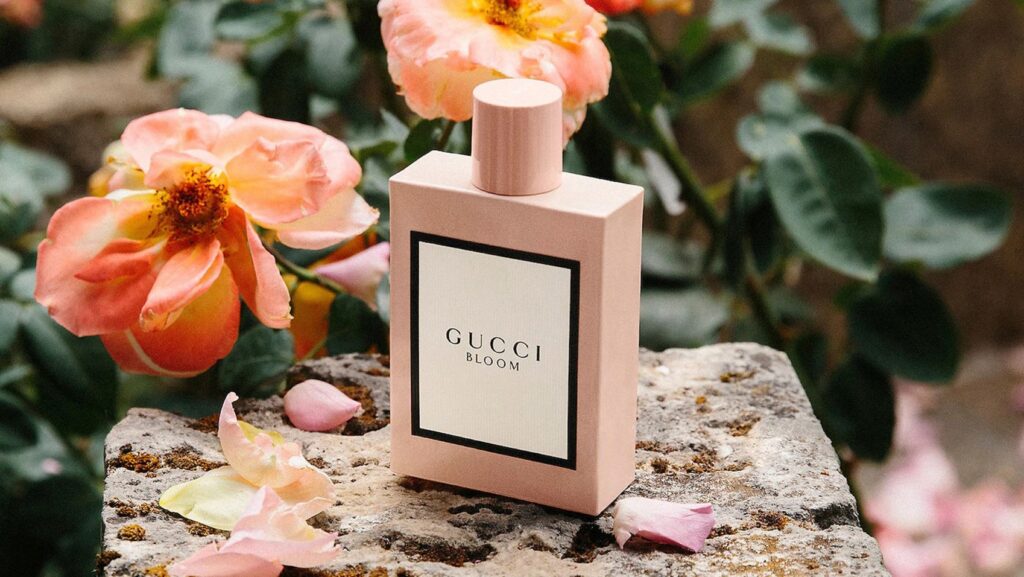
Application is Key: Less is More
Pulse Points: Apply perfume to pulse points where the skin is warmest – wrists, behind the ears, inside elbows, and the base of the throat. This enhances the diffusion of the scent.
Spray and Walk Through: For an even and subtle distribution, spray your perfume in the air and walk through the mist.
Avoid Rubbing: Rubbing your wrists together can break down the fragrance molecules, diminishing the scent. Dab instead.
Consider the Environment
Workplace: Opt for lighter, less intrusive scents in professional settings. Overpowering fragrances can be distracting and may cause discomfort for colleagues.
Public Spaces: In close quarters like public transportation or airplanes, go for a minimal application to avoid overwhelming others.
Special Events: For social gatherings, choose a scent that is pleasant yet distinctive, but remember to reapply lightly if needed.
Respect Sensitivities and Allergies
Sensitivity Awareness: Be mindful of people with fragrance sensitivities or allergies. In shared spaces, a light touch of perfume is considerate.
Fragrance-Free Zones: Honor fragrance-free zones in places like hospitals, clinics, and certain work environments. It’s respectful and often required.
Layering Fragrances

Consistency: Use products from the same fragrance line – shower gel, body lotion, and perfume. This creates a consistent scent profile that’s not overpowering.
Subtle Transitions: If you mix different scents, ensure they complement each other. Layering should enhance, not clash.
Storage Matters
Proper Storage: Store your perfume in a cool, dry place away from direct sunlight and temperature fluctuations. This preserves the fragrance’s integrity.
Shelf Life: Be aware of the shelf life. Most perfumes last between three to five years. If a scent smells off, it’s time to replace it.
Reapplication Tips
Travel-Sized Bottles: Carry a travel-sized bottle for touch-ups throughout the day. This ensures your scent remains fresh without overdoing it.
Blotting Technique: Use blotting papers to remove excess oil and then lightly reapply perfume to avoid buildup.
Wearing perfume is an art that requires a blend of personal style and social awareness. By following these etiquette guidelines, you can ensure your fragrance is always a welcome addition to your presence. Remember, the goal is to enhance your natural allure and leave a subtle, memorable impression.
Wellness
Art Therapy: The Healing Power of Creativity
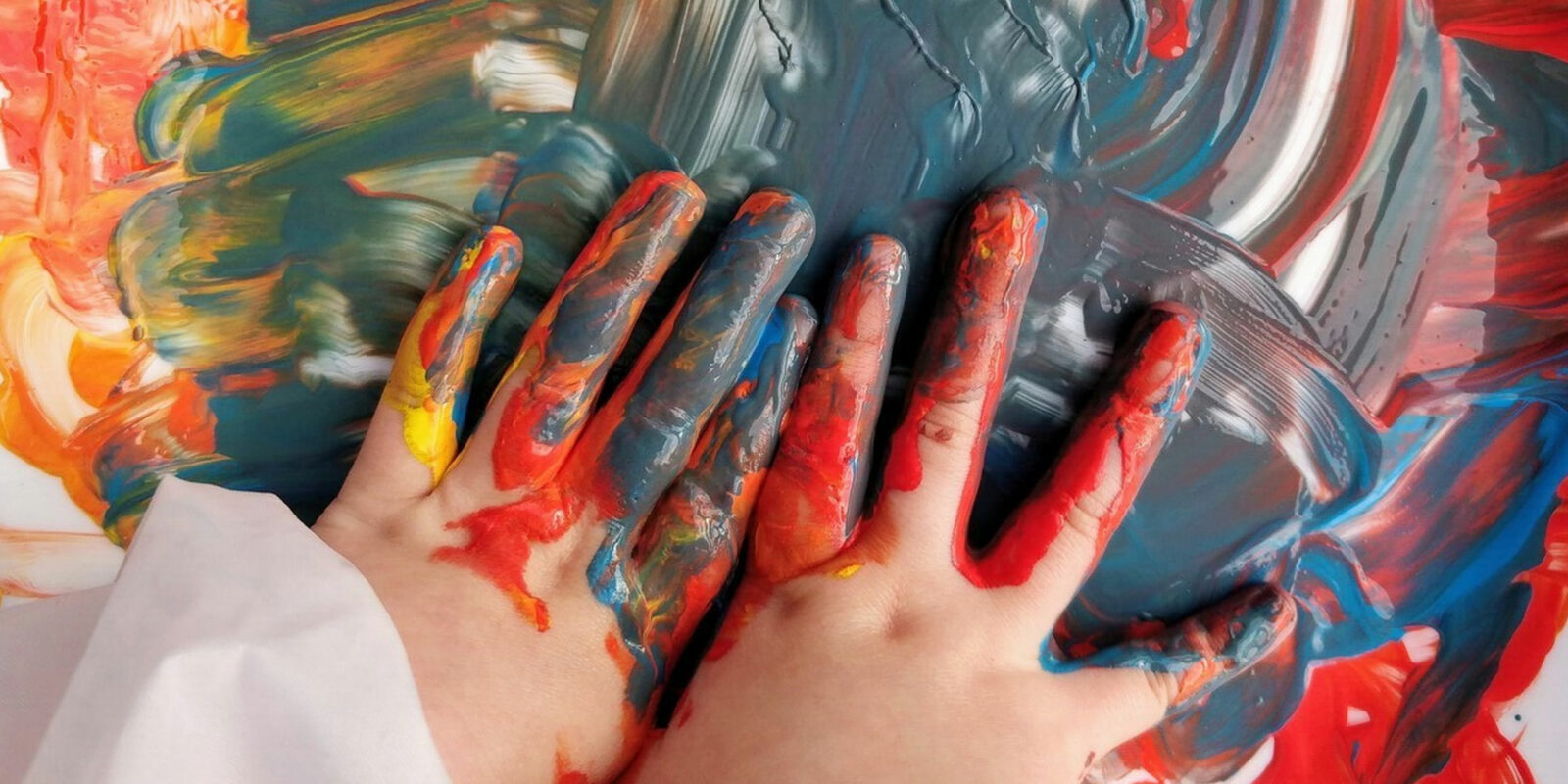
In a world filled with stress, anxiety, and emotional turmoil, finding solace and healing through creative expression has become increasingly recognized and valued. Art therapy harnesses the transformative power of creativity to promote emotional well-being, self-discovery, and healing. Let’s explore the profound impact of art therapy and how it can unlock the healing potential within all of us.
What is Art Therapy?
Art therapy is a form of psychotherapy that uses art-making as a therapeutic tool to explore and express emotions, thoughts, and experiences. Through various artistic mediums such as painting, drawing, sculpting, and collage, individuals are encouraged to tap into their inner creativity as a means of self-expression and self-discovery.
In art therapy sessions, trained therapists provide a safe and supportive environment for individuals to explore their feelings and experiences through art-making. Participants are guided through various exercises and prompts designed to stimulate creativity, encourage self-reflection, and promote emotional healing.

Art therapy offers a wide range of benefits for mental, emotional, and physical well-being:
- Emotional Expression: Art provides a non-verbal means of expressing emotions that may be difficult to articulate verbally.
- Stress Reduction: Engaging in creative activities can reduce stress levels and promote relaxation, helping individuals to cope with life’s challenges more effectively.
- Self-Exploration: Art-making allows individuals to explore their inner thoughts, feelings, and beliefs, fostering greater self-awareness and insight.
- Healing Trauma: Art therapy can be particularly effective in processing and healing trauma, providing a safe outlet for releasing pent-up emotions and transforming painful experiences.
- Enhanced Communication: For individuals who struggle with verbal communication, art therapy offers an alternative mode of expression, facilitating communication and interpersonal connections.

Art therapy is used in a variety of settings and populations, including:
- Mental Health Treatment: Art therapy is often used as part of treatment for individuals with mental health disorders such as depression, anxiety, PTSD, and eating disorders.
- Hospitals and Healthcare Settings: Art therapy is utilized in hospitals and healthcare settings to promote healing and well-being among patients coping with illness, chronic pain, or medical procedures.
- Schools and Education: Art therapy programs in schools help children and adolescents explore and process emotions, develop coping skills, and enhance self-esteem.
- Community and Social Services: Art therapy is used in community settings to support individuals facing life transitions, grief and loss, addiction recovery, and other challenges.

Interested in exploring art therapy? Here are some tips to get started:
- Find a Qualified Art Therapist: Look for a licensed art therapist who has completed specialised training and certification in art therapy.
- Experiment with Different Mediums: Don’t be afraid to explore different artistic mediums and techniques to find what resonates with you.
- Set Aside Time for Creativity: Make time in your schedule for regular art-making sessions, even if it’s just a few minutes each day.
- Embrace the Process: Remember that art therapy is not about creating a masterpiece; it’s about the process of self-expression and self-discovery.
Art therapy offers a powerful avenue for healing, self-expression, and personal growth. By tapping into our innate creativity, we can unlock the healing potential within ourselves and embark on a journey of self-discovery and emotional well-being. Whether you’re struggling with mental health challenges, navigating life transitions, or simply seeking greater self-awareness, art therapy offers a safe and supportive space to explore, express, and heal.
-

 Style11 months ago
Style11 months agoBridal Guide : Best Looks of Radhika Merchant Ambani
-

 Fashion1 year ago
Fashion1 year agoMost Discussed Ajrakh Saree of Alia Bhatt
-

 Entertainment1 year ago
Entertainment1 year agoThe Most Stylish Guests of Bhagya Suresh Reception
-

 Entertainment1 year ago
Entertainment1 year agoBridal Bliss : All Bridal Looks of Swasika Vijay
-

 Movies1 year ago
Movies1 year agoA Nostalgic Journey Through Love &Cinema : Best Bollywood Romantic 90s Movies
-

 AD8 months ago
AD8 months agoPopular Curtain Fabrics to Consider for Your Home
-

 Fashion1 year ago
Fashion1 year agoMajor Denim Trends You Need To Know in 2024
-

 Events9 months ago
Events9 months agoBest of Fashion Looks : Diya Krishna Wedding






































